Tomato Puree Market Research, 2032
The global tomato puree market was valued at $5.2 billion in 2022, and is projected to reach $7.7 billion by 2032, growing at a CAGR of 4.1% from 2023 to 2032. Tomato puree is a thick liquid or paste made by cooking and straining tomatoes to remove seeds and skins. Puree is a concentrated form of tomatoes that retains the rich flavor and vibrant color of the tomatoes. In the process of making tomato puree, tomatoes are first blanched for easy removal of upper layer and then crushed or blended to achieve a smooth consistency. The resulting puree is further used as a base for sauces, soups, stews, and other culinary dishes. It is a convenient ingredient for adding the essence of tomatoes to recipes without the use of whole tomatoes in various food applications.
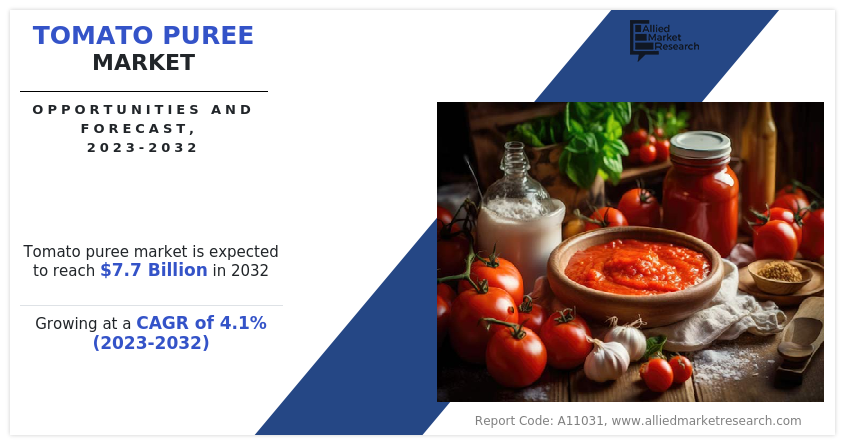
Market Dynamics
The growing demand for processed food has emerged as a significant driver for the increasing market growth of tomato puree. According to Northeastern University’s Network Science Institute, presently, ultra-processed foods constitute 73% of the U.S. food supply. In addition, the average adult in the U.S. obtains more than 60% of their daily calories from ultra-processed foods. As consumer lifestyles continue to evolve, there is a rising preference for convenient and time-saving food options. Processed foods, which often incorporate tomato puree as a key ingredient, offer quick and easy meal solutions for individuals with busy schedules. Tomato puree serves as a versatile base for a variety of processed food products, including sauces, soups, ready-made meals, and snacks. The use of tomato puree in these products enhances flavor and contributes to the rich color and nutritional content associated with tomatoes. The versatile application of tomato puree aligns well with the diverse range of processed foods available on the market.
Moreover, the health-conscious consumer trend has further fueled the demand for processed foods that maintain a balance between convenience and nutritional value. Tomato puree, being a good source of vitamins, antioxidants, and lycopene, adds a healthful component to processed food products. This health-conscious approach encourages manufacturers to incorporate tomato puree into their formulations, catering to the demand for taste and nutritional benefits. The convenience factor, coupled with the nutritional profile of tomato puree, positions it as a sought-after ingredient in the processed food industry. As a result, the tomato puree market size is expected to experience growth alongside the expanding market for processed foods, driven by the changing preferences and lifestyles of consumers globally during tomato puree market forecast.
Although the tomato puree market share has increased, it still faces certain challenges due to the fluctuation in the prices of tomatoes. Tomatoes are seasonal crops, and their prices can fluctuate based on seasonal changes in supply. A poor harvest due to unfavorable weather conditions, such as droughts or excessive rainfall, can lead to reduced tomato yields and increased prices. Moreover, the tomato market is subject to global trade dynamics. Events such as trade disputes, transportation issues, or disruptions in the supply chain can lead to fluctuations in tomato prices, directly affecting the cost structure of tomato puree production. Over the years, the global average prices of tomatoes, measured in USD per metric ton (mT), exhibited some fluctuations. In 2015, the price stood at $87.0 per mT, followed by a slight decrease to $79.0 in 2016. The subsequent years showed minor variations, with prices ranging from $81.0 to $88.2 in 2021, suggesting influences from factors such as agricultural production, market demand, and economic conditions in the global tomato market.
Tomato puree producers depend on a stable and predictable supply of tomatoes for their operations. Since tomato puree is a key derivative of fresh tomatoes, changes in the cost of raw tomatoes have a direct influence on the production cost of tomato puree. Fluctuating tomato prices can lead to variations in production costs, impacting the overall cost structure of tomato puree products. A sudden increase in tomato prices may result in increased production expenses, affecting profit margins of the manufacturers. Thus, the year-on-year fluctuation in prices of tomatoes is expected to hamper the tomato puree market growth.
There are many opportunities in the tomato puree market with an increase in demand for organic tomato puree products. According to the results released by the U.S. Department of Agriculture’s National Agricultural Statistics Service (NASS), the 2021 Organic Survey indicates total sales of $11.2 billion in organic products, reflecting a $1.28 billion, or 13%, increase from 2019. Thus, by introducing variations such as organic or flavored varieties of tomato purees, producers are expected to tap into evolving consumer preferences for healthier and more diverse food options. Organic tomato puree caters to the increasing demand for natural and sustainably produced products. With a focus on pesticide-free cultivation and environmentally friendly practices, organic tomato puree appeals to health-conscious consumers seeking cleaner and more eco-friendly food choices. Moreover, continuous innovation in tomato puree products is a key strategy for attracting new consumer segments and differentiating producers in the market, which is expected to drive the tomato puree market demand.
Segmental Overview
The tomato puree market is analyzed on the basis of nature, packaging, application, distribution channel, and region. By nature, the market is bifurcated into organic and conventional. By packaging, the market is segmented into glass jar, tin, and others. By application, the market is divided into food and beverage industry, food service industry, and retail. Depending on distribution channel, it is classified into B2B, supermarkets/hypermarkets, convenience stores, departmental stores, and online sales channel. Region-wise, the market is analyzed across North America (the U.S., Canada, and Mexico), Europe (Italy, Spain, Germany, Spain, France, Greece, Portugal, and the rest of Europe), Asia-Pacific (China, India, Japan, South Korea, Australia, and the rest of Asia-Pacific), Latin America (Brazil, Colombia, Argentina, and the rest of Latin America), and Middle East and Africa (GCC, South Africa, North Africa, and the rest of MEA).
By Nature
By nature, the conventional segment dominated the global tomato puree market in 2022 and is anticipated to maintain its dominance during the forecast period. Conventional farming methods are well-suited for large-scale production, allowing for the consistent and abundant supply of tomatoes. The scalability of conventional practices aligns with the high demand for tomato puree on a global scale, making it the preferred choice for manufacturers aiming to meet market needs efficiently. Conventional tomato farming typically involves the use of synthetic fertilizers and pesticides, leading to higher yields and lower production costs. This cost efficiency makes conventional tomatoes more economically viable for large-scale cultivation and subsequently influences the affordability of conventional tomato puree.
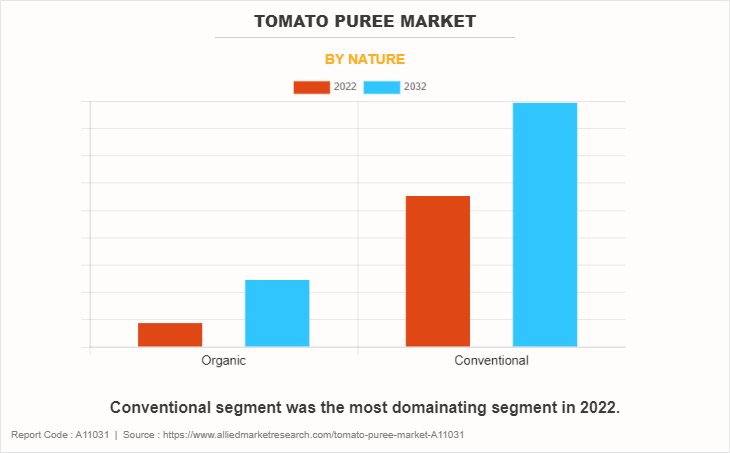
By Packaging
By packaging, the tin segment dominated the global tomato puree market in 2022 and is anticipated to maintain its dominance during the forecast period. In the tomato puree market, tin emerges as the most widely used packaging form due to its multiple advantages. Tin containers provide protection against light, moisture, and air, ensuring the longevity of the tomato puree by preserving its flavor, color, and nutritional integrity. The durability of tin cans safeguards the contents during transportation and handling, assuring that the product reaches consumers in optimal condition. Additionally, the cost-effectiveness of tin packaging makes it an economically viable choice for both manufacturers and consumers, which contributes to the overall competitiveness of tomato puree products. The easy-to-store nature of tin cans optimizes shelf space, enhancing logistical efficiency throughout the supply chain. Furthermore, the recyclability of tin aligns with the increasing consumer preference for sustainable packaging options, making it an environmentally friendly choice and meeting standards for responsible packaging practices in the industry.
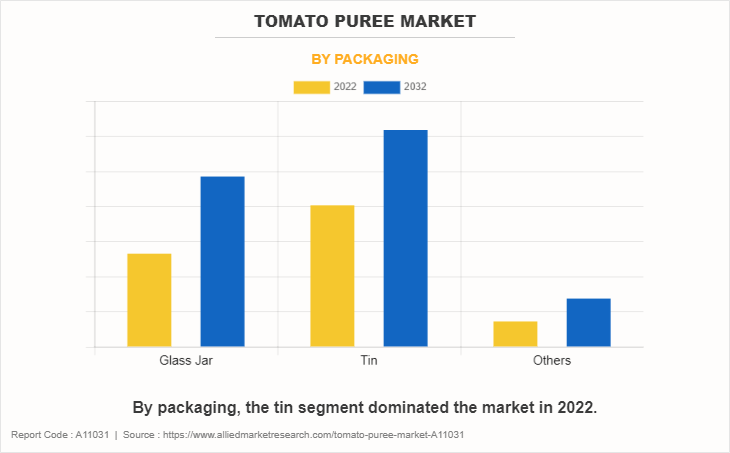
By Application
By application, the food and beverage industry segment dominated the global tomato puree market in 2022 and is anticipated to maintain its dominance during the forecast period. Tomato puree is a versatile base that adds rich flavor and vibrant color to a wide range of dishes, including sauces, soups, stews, curries, and pasta. The adaptability of tomato puree makes it an essential ingredient in diverse cuisines, driving demand across different food categories. Moreover, tomato puree serves as a convenient and time-saving ingredient in various recipes. It eliminates the need for washing, peeling, and chopping fresh tomatoes, making it a preferred choice for several businesses operating in the food industry.
Tomato puree, often packaged in aseptic containers or cans, has a longer shelf life compared to fresh tomatoes. This extended shelf life enhances storage and distribution capabilities, making it a reliable ingredient for food product manufacturers to meet their production needs throughout the year. Furthermore, tomato puree is a plant-based ingredient that aligns with vegetarian and vegan dietary trends. It is widely used in plant-based meat alternatives, pizzas, and other vegetarian products, contributing to its increased demand in the food service industry.
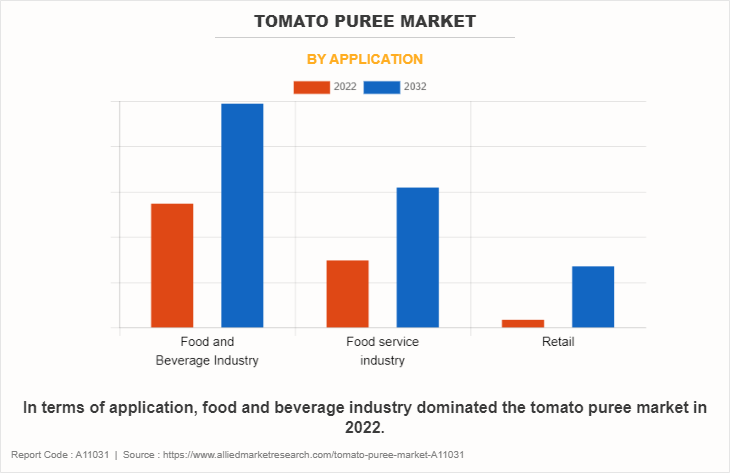
By Distribution Channel
By distribution channel, the B2B segment dominated the global tomato puree market in 2022. The B2B tomato puree ecosystem is comprised of multiple players, including manufacturers/suppliers, wholesalers/distributors, retailers, food service providers, food manufacturers, importers, and exporters. It consists of marketplaces where the vendor and the buyer of tomato puree make deals and transactions. The suppliers provide tomato puree direct from other businesses and go through a process where one business makes a transaction with another. Moreover, the B2B distribution channel does not involve any intermediaries and has smooth monetary transactions without any fraud. The B2B e-commerce evolution has introduced the path to digital procurement in the tomato puree industry. The adoption of digitalization in sales channels has made the work of manufacturers and vendors easy and smooth. In addition, the manufacturers display their products directly through digital marketing platforms Facebook, Instagram, Twitter, and Google. Therefore, manufacturers are able to expand their consumer base along with the improved perception of their brand.
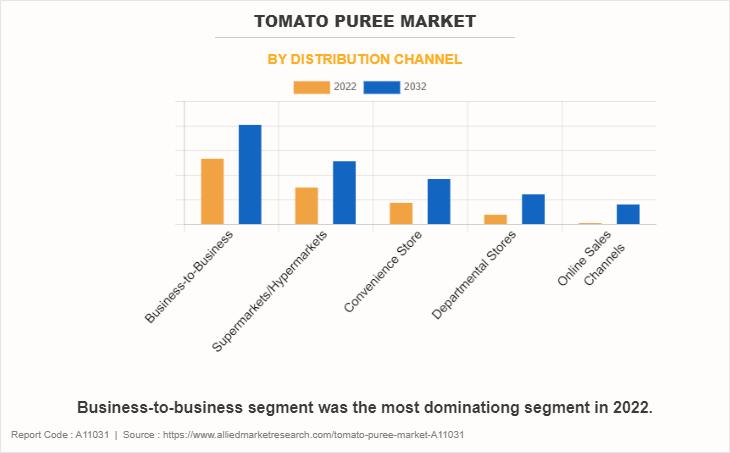
By Region
Region-wise, North America is anticipated to dominate the market with the largest share during the forecast period. North American cuisine incorporates a wide range of dishes that use tomato puree as a key ingredient. From pasta sauces and soups to salsas and stews, tomato puree is a versatile component in many popular dishes, contributing to its high demand in the region.
Furthermore, the North American region has a well-established processed food industry, and tomato puree is a common ingredient in various processed foods. Ready-made pasta sauces, canned soups, pizza sauces, and other convenience products often rely on tomato puree, driving demand for tomato puree products in the region.
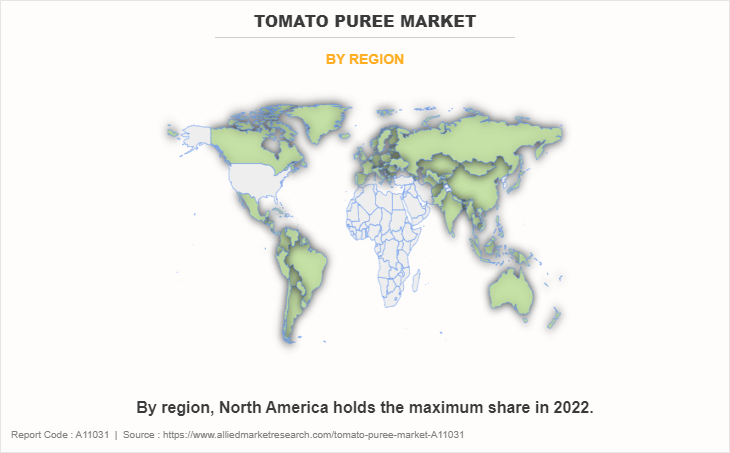
Competitive Landscape
The major key players include Neil Jones Food Company, Stanislaus Food Products, Kiril Mischeff Group, Conserve Italia Group, Sainsbury's, Riviana Foods Inc., Conagra Brands Inc., Del Monte Foods, Inc., Heinz Wattie’s Ltd., and Ariza b.v.
Several well-known and up-and-coming brands are vying for market dominance in the expanding tomato puree industry. Smaller, niche firms have become more well-known for catering to particular consumer demands and tastes. Large conglomerates, however, still control the majority of the market and frequently buy creative startups to broaden their product lines.
Private label brands created by merchants and e-commerce platforms are another aspect of the competitive market. While they provide more affordable options, they might have different recognition or range of products than well-known companies. An important competition component is innovation in formulations, ingredient sourcing, and sustainability policies. Brands that are able to change the tastes of their target market and align with their ethical and environmental values have an advantage over rivals.
Key Benefits for Stakeholders
- This report provides a quantitative analysis of the market segments, current trends, estimations, and dynamics of the tomato puree market analysis from 2022 to 2032 to identify the prevailing tomato puree market opportunities.
- The market research is offered along with information related to key drivers, restraints, and opportunities.
- Porter's five forces analysis highlights the potency of buyers and suppliers to enable stakeholders make profit-oriented business decisions and strengthen their supplier-buyer network.
- In-depth analysis of the tomato puree market segmentation assists to determine the prevailing market opportunities.
- Major countries in each region are mapped according to their revenue contribution to the global market.
- Market player positioning facilitates benchmarking and provides a clear understanding of the present position of the market players.
- The report includes the analysis of the regional as well as global tomato puree market trends, key players, market segments, application areas, and market growth strategies.
Tomato Puree Market Report Highlights
| Aspects | Details |
| Forecast period | 2022 - 2032 |
| Report Pages | 190 |
| By Nature |
|
| By Packaging |
|
| By Application |
|
| By Distribution Channel |
|
| By Region |
|
| Key Market Players | Sainsbury's, the neil jones food company, Conagra Brands Inc., Ariza b.v. , Heinz Wattie’s Ltd., Del Monte Foods, Inc., stanislaus food products, Conserve Italia Group, Riviana Foods Inc., Kiril Mischeff Group |
| | China Kunyu Industrial Co. Ltd., Aditi Foods Pvt. Ltd., Capricorn Food Products India Ltd. |
Analyst Review
The perspectives of the leading CXOs in the tomato puree industry are presented in this section. Rising consumer interest in healthy eating, global cuisine, and convenience cooking solutions fuels the demand for diverse and readily available tomato puree. Moreover, the popularity of Italian cuisine and culinary exploration drives the market for tomato puree products.
The growing interest in organic and sustainable tomato puree products is one of the significant trends for market growth. Brands are being driven to produce organic tomato puree as consumers' awareness regarding the benefits of the organic products over conventional ones grows. Recyclable packaging and natural and organic products have grown in popularity. In addition, convenient packaging formats such as tins and tubes cater to busy lifestyles and changing consumer preferences, which helps drive the demand for tomato puree market.
The tomato puree industry has also seen a digital transition, with e-commerce being a key factor. Online platforms provide wider reach and access to a global consumer base, bypassing traditional distribution channels. Consumers now acquire a variety of tomato puree from different brands more easily due to online sales channels, and other e-commerce sites. Social media sites are developed into effective marketing tools that enable firms to interact directly with their target audience. Thus, all such factors are expected to boost the tomato puree market growth.
The global tomato puree market was valued at $5.2 billion in 2022, and is projected to reach $7.7 billion by 2032
The global Tomato Puree market is projected to grow at a compound annual growth rate of 4.1% from 2023 to 2032
The major key players include Neil Jones Food Company, Stanislaus Food Products, Kiril Mischeff Group, Conserve Italia Group, Sainsbury's, Riviana Foods Inc., Conagra Brands Inc., Del Monte Foods, Inc., Heinz Wattie’s Ltd., and Ariza b.v.
Region-wise, North America is anticipated to dominate the market with the largest share during the forecast period.
Increasing consumer demand for convenient and ready-to-use cooking ingredients, Growing awareness of the health benefits associated with tomato-based products, Expanding foodservice industry, driving higher usage of tomato puree in restaurant and catering businesses
Loading Table Of Content...
Loading Research Methodology...


